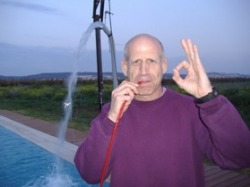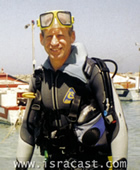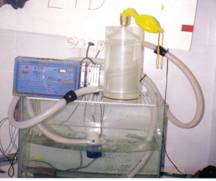Israeli Breathing Aparatus
Alan Izhar-Bodner the Israeli inventor created a breathing aparatus consisting of batteries, a motor, a pump, an oxegen separater, a flexible airbag that holds about 8 liters, a carbon dioxide scrubber (optional) and a small reserve tank of compressed air.
Early model
How does it work?
This machine works due to Henry's Law. The amount of gas that can be dissolved in a liquid body is proportional to the pressure on the liquid body. Lowering the pressure releases more gas, through the use of spinning centrifuges which are powered by batteries. The spinning centrifuges create a sealed chamber.
Prototype

Inventor Alan inhaling some dissolved oxygen
Sources:
http://www.isracast.com/article.aspx?id=63
http://www.likeafish.biz/
Interview with the Inventor (from http://www.isracast.com/article.aspx?id=63)
Transcript of the Interview with Alon Bodner:
Question: We are speaking now with engineer Alon Bodner. First of all I have to tell you that since we put up your report on IsraCast, we have been inundated with literally millions of people going into our website to find out about your invention. Just where did you get the idea sir?
Bodner: My seven years old son, Aviv, asked me some questions about the possibility of diving without tanks, maybe he was inspired by a Star Wars' movie, and then the wheels in my head started spinning. I knew that there is dissolved air in the water and that the fish breath this air so I thought, with all the technology in the world, why couldn't we also do it?
Question: But just how practical is your idea, have you actually tried to run through this prototype in a pool or that kind of thing?
Bodner: I call it a lab model it's not yet a prototype, it's in an aquarium which has a pump, a centrifuge, some hoses and a balloon, we cannot take it into the water yet, into the sea, but we tried it out with water and we saw that in principle it works.
Question: In principle it works. We've been getting inquiries from people all around the world, some are asking what about the quantity, the large quantities of water that might have to be processed in order to get an adequate amount of oxygen for a diver?
Bodner: I want to distinguish between open diving systems and closed diving systems. Usually when you go sports diving it's with open systems and this means that you inhale air from a tank and you exhale it into the water, and this requires a very large quantity of air. With closed systems, such as with breathers for individual divers or submarines or maybe in the future underwater habitats, the required water flow is much smaller, so this device is very suitable.
Question: In other words, it could be a portable apparatus?
Bodner: It is supposed to be a portable apparatus, yes.
Question: And when you speak of underwater habitats, just what do you have in mind?
Bodner: Well right now there exists several underwater habitats especially for research, off the coast of Florida there is one. It's like a Spacelab in the past, in which a few scientists live 10-20 meters underwater, they breath from compressed tanks and perform experiments. In the future, you can have a whole city or many people under a glass dome and breathing air straight from this device.
Question: What about the scientific community, have you yourself been approached by scientists and so forth?
Bodner: Well I have, a few people do not understand the concept, they assume that I separate oxygen from the water and they say correctly that it is toxic below a depth of seven meters and then they ask some technical questions. In this case I want to say again, the device can extract air from the water. It is dissolved air which contains oxygen and nitrogen and so on. It does not extract oxygen from hydrogen.
Question: And what are some of the technical problems that you have to overcome at this stage?
Bodner: The main concerns are the power of the batteries I suppose and the water flow. The batteries are evolving in a very good rate and we don't expect any problems right now. As I said the water flow can be a problem, especially if using open systems, if you want I can elaborate better calculations.
Question: If you could, please.
Bodner: The calculation is quite different for open or closed systems; I'll start with the calculations for open systems. A diver can consume about 25 liters per minute of air at the surface. Assuming that there's about 2 percent of dissolved air in the water, the calculations show the water flow requirement of 1,250 liters per minute. As you go deeper your lungs require more air. At 10 meters depth the air and water flow requirement is double than that on the surface so that means that you will need 2,500 litters per minute of water, and this is a lot. For closed systems, the calculation is different. In these systems the air is re-circulated and returned to the diver after the carbon dioxide is removed. For this case we calculate the oxygen consumption rate and not the air consumption rate as before. Say a diver consumes one liter per minute of oxygen, and unlike the above calculation your body requires the same amount of oxygen at all depths. So, assume there is about half a percent of dissolved oxygen in the water, this result in the water flow requirement of only 200 liters per minute at all depths, which is not too bad, and we can make a compact machine for this.
Question: Engineer Bodner, you are a diver yourself?
Bodner: Yes, lately I dive mainly in the Red Sea in Eilat and in the Mediterranean Sea, in the past I also dived in the Bahamas and off California.
Question: So you can be a guinea pig for your own invention now?
Bodner: I'd love to, but there are also many other volunteers, I get lots of e-mail from people all over the world who want to volunteer, to be among the first to use the systems.
Question: OK, let's go to the big question now. How long do you estimate that it might take before your remarkable invention actually goes on the market, becomes marketable, in a finished product?
Bodner: I expect the complete work the complete working prototype in about two years; this is provided if I get more funding, a commercial product will be ready shortly thereafter.
Question: Well, what can we say, perhaps when the Wright brothers talked about people flying like birds in the air, you're following in their footsteps and talking about people that can swim like fish in the sea.
Bodner: Well I hope so but it's too early still to compare me with the Wright brothers but I appreciate the comparison.
Question: Have you had approaches from manufacturing companies and so forth?
Bodner: I have but the discussions are still at early stages so of course I cannot divulge which names I'm speaking to.
Iddo Genuth, Tomer Yaffe
Question: We are speaking now with engineer Alon Bodner. First of all I have to tell you that since we put up your report on IsraCast, we have been inundated with literally millions of people going into our website to find out about your invention. Just where did you get the idea sir?
Bodner: My seven years old son, Aviv, asked me some questions about the possibility of diving without tanks, maybe he was inspired by a Star Wars' movie, and then the wheels in my head started spinning. I knew that there is dissolved air in the water and that the fish breath this air so I thought, with all the technology in the world, why couldn't we also do it?
Question: But just how practical is your idea, have you actually tried to run through this prototype in a pool or that kind of thing?
Bodner: I call it a lab model it's not yet a prototype, it's in an aquarium which has a pump, a centrifuge, some hoses and a balloon, we cannot take it into the water yet, into the sea, but we tried it out with water and we saw that in principle it works.
Question: In principle it works. We've been getting inquiries from people all around the world, some are asking what about the quantity, the large quantities of water that might have to be processed in order to get an adequate amount of oxygen for a diver?
Bodner: I want to distinguish between open diving systems and closed diving systems. Usually when you go sports diving it's with open systems and this means that you inhale air from a tank and you exhale it into the water, and this requires a very large quantity of air. With closed systems, such as with breathers for individual divers or submarines or maybe in the future underwater habitats, the required water flow is much smaller, so this device is very suitable.
Question: In other words, it could be a portable apparatus?
Bodner: It is supposed to be a portable apparatus, yes.
Question: And when you speak of underwater habitats, just what do you have in mind?
Bodner: Well right now there exists several underwater habitats especially for research, off the coast of Florida there is one. It's like a Spacelab in the past, in which a few scientists live 10-20 meters underwater, they breath from compressed tanks and perform experiments. In the future, you can have a whole city or many people under a glass dome and breathing air straight from this device.
Question: What about the scientific community, have you yourself been approached by scientists and so forth?
Bodner: Well I have, a few people do not understand the concept, they assume that I separate oxygen from the water and they say correctly that it is toxic below a depth of seven meters and then they ask some technical questions. In this case I want to say again, the device can extract air from the water. It is dissolved air which contains oxygen and nitrogen and so on. It does not extract oxygen from hydrogen.
Question: And what are some of the technical problems that you have to overcome at this stage?
Bodner: The main concerns are the power of the batteries I suppose and the water flow. The batteries are evolving in a very good rate and we don't expect any problems right now. As I said the water flow can be a problem, especially if using open systems, if you want I can elaborate better calculations.
Question: If you could, please.
Bodner: The calculation is quite different for open or closed systems; I'll start with the calculations for open systems. A diver can consume about 25 liters per minute of air at the surface. Assuming that there's about 2 percent of dissolved air in the water, the calculations show the water flow requirement of 1,250 liters per minute. As you go deeper your lungs require more air. At 10 meters depth the air and water flow requirement is double than that on the surface so that means that you will need 2,500 litters per minute of water, and this is a lot. For closed systems, the calculation is different. In these systems the air is re-circulated and returned to the diver after the carbon dioxide is removed. For this case we calculate the oxygen consumption rate and not the air consumption rate as before. Say a diver consumes one liter per minute of oxygen, and unlike the above calculation your body requires the same amount of oxygen at all depths. So, assume there is about half a percent of dissolved oxygen in the water, this result in the water flow requirement of only 200 liters per minute at all depths, which is not too bad, and we can make a compact machine for this.
Question: Engineer Bodner, you are a diver yourself?
Bodner: Yes, lately I dive mainly in the Red Sea in Eilat and in the Mediterranean Sea, in the past I also dived in the Bahamas and off California.
Question: So you can be a guinea pig for your own invention now?
Bodner: I'd love to, but there are also many other volunteers, I get lots of e-mail from people all over the world who want to volunteer, to be among the first to use the systems.
Question: OK, let's go to the big question now. How long do you estimate that it might take before your remarkable invention actually goes on the market, becomes marketable, in a finished product?
Bodner: I expect the complete work the complete working prototype in about two years; this is provided if I get more funding, a commercial product will be ready shortly thereafter.
Question: Well, what can we say, perhaps when the Wright brothers talked about people flying like birds in the air, you're following in their footsteps and talking about people that can swim like fish in the sea.
Bodner: Well I hope so but it's too early still to compare me with the Wright brothers but I appreciate the comparison.
Question: Have you had approaches from manufacturing companies and so forth?
Bodner: I have but the discussions are still at early stages so of course I cannot divulge which names I'm speaking to.
Iddo Genuth, Tomer Yaffe



